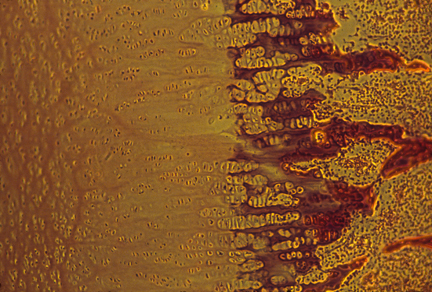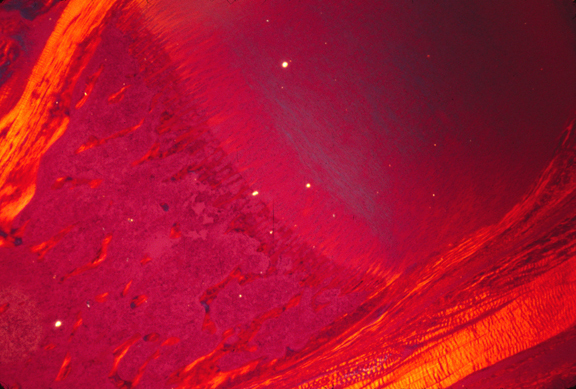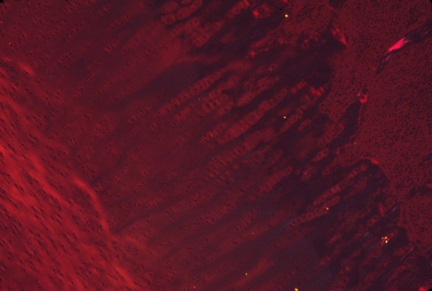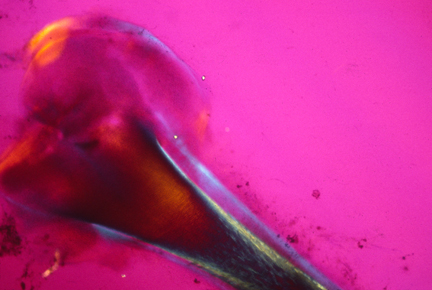Embryology Biology 441 Spring 2010 Albert Harris
�������������������������������������������������Review Questions for Third Examination
Is it practical to make tissue cultures of cells from higher plants? How can tissue culture be used to help save endangered species of plants? Do you know any specific kinds of plants in which this method has been used to help save them? * Why would this not have worked if plant cell differentiation were irreversible? *Can you invent a science fiction plot based on using animal tissue cultures for similar functions? *Isn't the plan to use "embryonic stem cells" something like this? If you had a drug or other treatment that would stimulate reversal of differentiation in animal tissue culture cells, shouldn't that accomplish the same function as is predicted for "embryonic stem cells"?
In what sense is cauliflower the result of a homeotic mutation? The mutation in question causes each petal of the plant's flowers to try to develop into an entire what? Have equivalent mutations been found in the model organism Arabidopsis? What do these mutations cause the Arabidopsis plants to develop, instead of flowers?
Are cells of any higher plants able to crawl from place to place, or exert traction forces, like animal cells? (no)
Why not? (completely surrounded by cell walls) Can cell walls stretch? (If the osmotic pressure exerted by the plant cells is strong enough) In what two ways can enlargement of particular cells of higher plants be caused to occur in a particular area? (Either by weakening of the cellulose cell walls, or by increased osmotic pressure) How can a plant cell increase its osmotic pressure? (either by synthesizing more sugars or other molecules, or by enzymatically cleaving chains of sugars into shorter lengths or individual sugars)
A concentration difference of one mole (as many grams as the molecular weight of the molecules) causes how strong an osmotic pressure (22.4 atmospheres of pressure). **If you had a certain concentration of disaccharides (or dimers of amino acids) in the cytoplasm of a cell, and they contributed X amount of osmotic pressure, then how much (if at all?) would the osmotic pressure be changed if you cleaved all the disaccharides into monosaccharides? Answer: the pressure would be increased by X. Double the concentration of dissolved molecules produces double the osmotic pressure, even if you double the number of molecules by spitting molecules in two! Most biologists don't realize that, but it's important, and can be useful knowledge, although it isn't embryology.
When plant growth is directed along a particular axis, as when a stem grows, or a leaf changes shape, or a spine forms, then is the directionality of cell enlargement caused by osmotic pressure being made stronger in some directions than others, or is it caused by directional weakening of cell walls? Hint: osmotic pressure is a scalar variable? Mechanical resistance to stretching is a fourth rank tensor! So which variable can differ with direction? And which one can't? This is an example why shape formation mechanisms can only be understood by people who know the differences between scalars and tensors.
**Do you consider that non-determinate growth, in the sense of each tree and bush having a different branching pattern, is or is not a fundamental difference between animals and plants? Lots of biologists do. But corals and sponges and bryozoans and lots of other invertebrate phyla vary like plants in this respect. So if there is a fundamental difference of this kind, its not between animals and plants, but between some animals and others.
Are seeds equivalent to eggs? Or to fertilized eggs? Or to gastrula or neurula stage embryos? Why?
What is a cotyledon? In a peanut, which parts are the cotyledons? Which part becomes the stem and the root of the plant?
What is a meristem? In what parts of a plant's anatomy are mitotic divisions concentrated? Where are shoot meristems? Where are root meristems? What special kinds of meristems are called cambia ("cambium" singular)? What is formed by the cork cambium of a tree? What is synonymous to "lateral meristem"?
What is auxin? (the plant hormone indole acetic acid)
Where is auxin secreted? (in the tip of growing shoots)
Which direction are auxin molecules actively pumped from cell to cell? (Downward, relative to gravity)
What mechanical changes are induced by auxin? (Weakening of plant cell walls, so that plant cells enlarge.)
What effect does sunlight have on auxin? (Causes destruction of auxin, lowering its concentration where light is brightest)
Why do plant stems bend toward light?
Why do plant stems bend upward, toward a vertical direction?
Auxin stimulates differentiation of which part of a plant? (Roots)
Why do roots differentiate at the bottom of a plant, and why do new roots develop at the bottom of a cutting from a stem.
What chemical should you dip a cutting into, in order to stimulate root differentiation? Five letter name, starts with an a.
* What scientist predicted that a chemical would be discovered, that would have all these properties? (Charles Darwin)
* Because auxin also inhibits formation of side branches, how can trimming a hedge or other plant make it produce more branches?
What are the names of two or three other plant hormones?
Explain the importance of bioassays in discovering what specific chemical signal causes a certain effect.
Explain why wikipedia and other popular sources are sadly misguided to say that bioassays are methods to measure the amount of particular chemicals.
Compare and contrast the osmotic pressure in plant cells and the electro-osmotic pressure in cartilage.
Explain why wikipedia and encyclopedias are sadly misguided to define electro-osmosis as the use of an electrical voltage to move ions through a membrane.
What functions are served by disks of cartilage in your ankles, knees, and hip joints? (mechanical support, and greatly reduced friction of movement)
What force resists the compression of these and other cartilages? (Electro-osmosis)
Do ions move across membranes when a cartilage resists a load? (no, but positive ions and water are squeezed outward through the cartilage surface, which is not a membrane.)
Does cartilage change into bone? (No. It gets destroyed and replaced by bone having the same shape.)
* Consider the analogy, if people believed that sculptors convert wax into bronze, when making statues.
Does calcium phosphate and carbonate sometimes precipitate in cartilage? (Yes, it's called calcification)
How does that differ from changing cartilage into bone? (The cartilage is still there; plus bone is more than just calcium phosphate.)
Are there any kinds of animals in which the embryonic skeleton is mostly made out cartilage? (All vertebrates, including humans)
Do some kinds of animals continue to have a skeleton made out of cartilage? (Sharks, salamanders)
What happens when a person has a "slipped disk"? (ripping of the surface of the fibrous cartilages between vertebrae)
*How much do slipped disks hurt, on a scale of a million to a billion? (Imagine if a truck were parked on your foot!)
Please invent a medical treatment by which "slipped" disks could be stimulated to reshape themselves, back to their original shape.
*If MDs believe the dictionary definition of electro-osmosis, then what chance do they have of inventing such improvements in medical treatment? (On a scale of slim to none?)
What treatments are used instead? (Screwing metal screws through the adjacent vertebrae, attaching them to metal or plastic sheets.)
When a cartilage elongates in a certain direction, why it is impossible that the directionality results from cartilage cells either secreting more cartilage in that direction, or from the cells preferentially growing in that direction? Why does the cause have to be channeling of expansion in that direction, either by preferential weakening of those collagen fibers that are oriented in the longitudinal direction, or by greater strength of the collagen fibers wrapped around the sides of the cartilage? (Osmotic pressure is a scalar variable, which can vary from one place to another, but which is incapable of varying with direction at any given pointÉin contrast to what other mechanical forces, which belong to what category of variable?)
Why are these facts crucial to understand if you are to be able to improve medical treatment of damaged cartilages?
What mechanical force causes the "growth" of the lobes of the brain, and the optic vesicles? (fluid pressure, NOT osmotic, of water pumped into the neurocoel, combined with localized weaknesses at certain locations near the anterior end of the neural tube.
What are the four extra-embryonic membranes that occur in development of birds? What about in mammals? In reptiles?
Do amphibians have any extra-embryonic membranes? (No) What about fish? (Teleosts have enveloping layers any yolk syncytial membranes; sharks and rays have other kinds of extra-embryonic membranes, which we won't learn about)
Can you draw the geometric arrangements of the 4 extra-embryonic membranes in mammals, and in birds?
Which one is called "the bag of waters"?
How are these related to the placenta, in mammals, and to the transfer of oxygen and food from the uterus to the embryo?
Where is the extra-embryonic coelom? Why is it called by this name? What space inside the body is it connected to?
NOTE: THIS LIST OF QUESTIONS IS STILL IN THE PROCESS OF BEING WRITTEN. IT ISN'T FINISHED YET, BUT IS POSTED IN THIS INCOMPLETE FORM SO AS TO GIVE YOU A HEAD START STUDYING. I ALSO HOPE THE SPROUTING LEAVES AND FLOWERS WILL STIMULATE YOUR DESIRE TO UNDERSTAND THE BIOLOGICAL MECHANISMS THAT ARE CAUSING THEM.
BUT NO MORE QUESTIONS WILL BE INSERTED ABOVE THE ONE ABOUT THE EXTRA-EMBRYONIC COELOM; IF ANY ADDITIONAL QUESTIONS ARE ADDED ON ANY OF THE SUBJECTS ABOVE, THOSE FURTHER QUESTIONS WILL BE PUT LOWER DOWN THE LIST.
Which ones of the following have "belly buttons"(at least when young): Birds, Snakes, Turtles, Platypuses, Frogs, Salamanders
What is an umbilical cord? Parts of which extraembryonic membranes run down the length of a the umbilical cord? Does this vary with species? (not among those that have umbilical cords. Are there any egg-laying snakes? (most species) Are there any live-bearing snakes? (copperheads, among others **It is generally assumed that the amnion, chorion, yolk sac, and allantois all first evolved
in egg laying animals (presumably early reptiles), and only later evolved to be part of placentas of live-bearing animals: Can you think of an alternative hypothesis? **Is your hypothesis supported or contradicted by the existence of some live bearing reptiles, and some egg-laying mammals? (Hint: Is it conceivable that live-bearing animals evolved some or all of these 4 extraembryonic membranes?) Incidentally, there are live-bearing teleost fish in which nutrients, oxygen, etc. are transferred between tissues of the ovary and of the pericardium!
What are at least two fundamental differences in early stages of development between flies versus vertebrates (that tend to suggest fundamental differences in the embryonic mechanisms they use to control development of anatomical axes and cell differentiation).
What are at least two kinds of molecular evidence that vertebrates and flies use basically the same mechanisms to control development, after all!?
* Can you think of some better analogies than I did (in relation to twinning) than two shirts being sewn out of the same original piece of cloth, or two pots being molded out of the same original piece of clay? * Invent some comparable analogies for development of chimeric mice?
What are the three different ways in which identical twinning occurs in humans and other mammals? Conjoined ("Siamese") twins occur in a small percentage of those twins that form in which of these three ways of twin formation? Long range diffusion gradients, or other long range signals, are often hypothesized as part of what controls where organs develop, relative to one another: * Do you think such signals might sometimes extend from one identical twin to the other? * What detectable results might this have? (I can think of two; both of which actually occur; but you may be able to think of those two and more. * Based on your knowledge of the experimental results for which Spemann won a Nobel prize, what results would you expect if two embryos developed very close to each other, and why? [There are some interesting drawings in Slack's book of chicken embryos that had been cut in halves or thirds at early stages] You know about the development of chimeric mice: Suggest what sorts of anatomical abnormalities should result if what slack calls "regional specification" had already occurred in some of the cells of the fused mouse embryos.
Suggest one or more reasons why Spemann didn't get the equivalent of chimeric mice, instead of discovering induction?
Why would it be impossible to make chimeric flies? ...but maybe possible to make viable chimeras using certain kinds of wasps?
List differences and similarities between capillaries, veins, arteries and lymphatic ducts. What are endothelial cells? Are they endodermal, despite what the name seems to suggest? Rank these 4 in order of the pressure of blood that they normally resist.
Explain why this is NOT the order of relative thickness and tensile strength of their walls. Which ones have the thickest walls? Which have the thinnest walls? Which have walls of intermediate thickness? In addition to endothelial cells, what are some other components of the walls of arteries and veins? Mutant mice homozygous for defective genes coding for collagen die when their hearts start to beat, because their arteries burst: how do you interpret this observation? What are some possible mechanisms by which collagen gets wrapped tightly around developing arteries? Skeletal muscles have a (not very well understood) mechanism that causes them to get stronger in response to vigorous exercise? What other tissues or organs also get stronger in response to being subjected to strong forces? What are some theories about how the cells of these tissues detect the magnitudes of the forces imposed on them?
What is piezo-electricity? Is it a special kind of electricity? Or a particular way of creating temporary voltages? Can cartilage also create voltages when compressed or stretched; and how is this voltage related to the force that resists compression of cartilage?
If pieces of bone and cartilage were very close or attached to each other, suggest a reason why it wouldn't be practical to use piezoelectric voltages to control increases in bone strength. (Hint: would electro-osmotic voltages be distinguishable from piezoelectric voltages. Tennis players bones get much stronger in whichever arm the serve with: what is believed to be the explanation? *Can you invent any other explanations? *If the true mechanism were known, suggest some good medical uses for it.
*Conversely, suggest how the mechanism would be exploited by professional baseball players! Suggest experimental criteria for testing whether or not any given hypothetical explanation for tissue strengthening (Including observing what professional baseball players are doing).
In bone, the tension-resisting component is what material (Type I what?)? In cartilage, what is the tension-resisting element?
*In fiber-glass and reinforced concrete, what are the tension-resisting and the compression-resisting components of these composite materials? What are the compression-resisting components of bone, and of cartilage? Which of these materials can grow only by addition of more material at the surface, and which can grow either by additional material at the surface, OR by internal expansion?
How is electro-osmosis necessary for this ability to enlarge by internal swelling? Compare it to the growth of plants by osmotic swelling. Explain why enzymatic cutting of some of the collagen fibers inside a bone will make it weaker (more brittle, in particular)
In contrast to the effects if cutting of some of the collagen fibers inside (or surrounding) a piece of cartilage, which will cause it to get bigger! (as well as a little weaker). * If you had a magic wand that was able to cause ocean water to become much stronger in one location than another, why would an osmotic pressure be exerted on the magic wand?

The photograph above is a section through the boundary between cartilage and bone in an endochondral bone of a young mammal.
On the left side, it is pure cartilage; on the right side the cartilage has been replaced by bone.
Can you find the boundary between cartilage and bone? Describe the changes in sizes of chondrocytes, and arrangements of these chondrocytes relative to each other, and relative to what appear to be bundles of collagen, as the region of "ossification" (bone formation) spreads gradually from right to left. What tensions and pressures must be changing, in order to explain these geometric changes of cell shapes and arrangements? For example, where would you interpret that tension in collagen fibers is the same in every direction? And where does this tension become progressively aniosotropic (more in which direction than in which other direction?)?
Where is the electro-osmotic pressure high? Where does it gradually get less? How are changes in electro-osmotic pressure related to changes in sizes, shapes, and arrangements of chondrocytes? Please contrast these shapes and arrangements with those in articular cartilage. Can you suggest reasons for these differences? *I surmise, but don't know how to test directly, that the cytoplasm of chondrocytes must have unusually high osmotic pressures (i.e. the pressure due to greater concentrations of dissolved molecules and ions, relative to the concentrations outside their plasma membranes) and would be grateful as well as favorably impressed by any students' suggestions on this question, which might be medically important.
The two color photographs below are of the same section as the one above, as seen by polarized light, which produces blue colors where the predominant orientation of fibers (collagen, mostly) are in one direction, and yellow colors where the predominant orientation of fibers are in the direction perpendicular to the direction that makes them look blue. Try to figure out what can be deduced about the mechanics of cartilage replacement by bone.


The picture below is NOT a section, but a whole cartilage seen in polarized light. See if you can figure out what is going on.

A FEW MORE QUESTIONS, POSTED SUNDAY EVENING:
What blocks arteries in atherosclerosis? What are two theories to explain how it occurs? What key fact about atherosclerosis is not predicted by either of these theories? How does fetal hemoglobin differ from the adult form? What would happen if a person continued making fetal hemoglobin as an adult?
What do osteocytes and osteoclasts do? What happens if one of these cell types is more active than the other? How do forensic pathologists estimate the age at death from a skeleton? What is the genetic defect in dachshunds?
If a person donates one kidney for a transplant, what happens to the other kidney? What is a possible explanation?
What makes Drosophila a good research organism? What is meant by a genetic screen? What is peculiar about the early cleavage divisions of fly and (most!) other arthropod embryos, up until about the 6,000 cell stage (in contrast to any vertebrate embryos)? What are imaginal disks? How are they involved in the metamorphosis of maggots into flies, and caterpillars into butterflies? If the effect of a mutation is to cause a fly to develop an extra pair of legs where its antennae should be, what kind of mutation is this called? What went wrong? Do any other kinds of animals have genes with base sequences similar to the genes that can produce this kind of abnormality when mutated?
��������������������������������������������������������������������������������